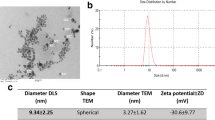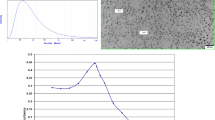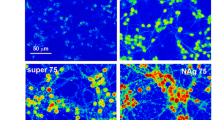Abstract
Silver nanoparticles (AgNPs), due to their metallic nature, are increasingly used in biological, optical, and electrical applications. Some reports indicate that AgNPs can induce damage in the central nervous system (CNS), yet little is known about the physiological responses to any such damage. The goal of this work was to investigate the histological cerebellar cortex damage caused by an intraperitoneal administration of AgNPs (15 mg/kg) in rats, and if this damage could be prevented by 24 h of previous treatment with ZnCl2 (27 mg/kg), as well as to evaluate if these effects are associated with the expression of N-Cadherin in the cerebellum. We showed that AgNPs induced damage in the different layers of the cerebellum. Expression of N-Cadherin increased in the white matter after AgNPs and ZnCl2 + AgNPs treatment, and in all cerebellar cortical layers after ZnCl2 + AgNPs administration. We find that N-Cadherin is acting as a mediator of the neuroprotective process against the damage induced by AgNPs in the cerebellar cortex, and this neuroprotective role is enhanced by extracellular Zn.
Graphical abstract





Similar content being viewed by others
References
Specification PA (2007) Terminology for nanomaterials: British Standards Institute London. https://www.mendeley.com/catalogue/3708dfb2-946d-3ec0-99eb-49b409534225/?utm_source=desktop&utm_medium=1.19.4&utm_campaign=open_catalog&userDocumentId=%7B315720f1-1e92-489b-93d6-cc569f8d47c8%7D
Kolahalam LA, Kasi Viswanath IV, Diwakar BS, Govindh B, Reddy V, Murthy YLN (2019) Review on nanomaterials: synthesis and applications. Mater Today Proc 18:2182–2190. https://doi.org/10.1016/j.matpr.2019.07.371
Zhang XF, Liu ZG, Shen W, Gurunathan S (2016) Silver nanoparticles: synthesis, characterization, properties, applications, and therapeutic approaches. Int J Mol Sci 17(9):1534. https://doi.org/10.3390/ijms17091534
Wiesner MR, Lowry GV, Jones KL, Hochella MF Jr, Di Giulio RT, Casman E, Bernhardt ES (2009) Decreasing uncertainties in assessing environmental exposure, risk, and ecological implications of nanomaterials. Environ Sci Technol 43(17):6458–6462. https://doi.org/10.1021/es803621k
Papp T, Schiffmann D, Weiss D, Castranova V, Vallyathan V, Rahman Q (2008) Human health implications of nanomaterial exposure. Nanotoxicology 2(1):9–27. https://doi.org/10.1080/17435390701847935
Barabadi H, Mojab F, Vahidi H, Marashi B, Talank N, Hosseini O, Saravanan M (2021) Green synthesis, characterization, antibacterial and biofilm inhibitory activity of silver nanoparticles compared to commercial silver nanoparticles. Inorg Chem Commun 129:108647. https://doi.org/10.1016/j.inoche.2021.108647
Barabadi H, Mostafavi E, Truong LB, Cruz DM, Vahidi H, Mahjoub MA, Hosseini O, Saravanan M (2022) Microbial nanotechnology–based approaches for wound healing and infection control. In: Handbook of Microbial Nanotechnology: Academic Press p. 1–15. https://doi.org/10.1016/B978-0-12-823426-6.00009-7
Barabadi H, Jounaki K, Pishgahzadeh E, Morad H, Sadeghian-Abadi S, Vahidi H, Mahjoub A, Hosseini O, Saravanan M (2022) Antiviral potential of green-synthesized silver nanoparticles. In: Handbook of Microbial Nanotechnology: Academic Press p. 285–310. https://doi.org/10.1016/B978-0-12-823426-6.00009-7
Talank N, Morad H, Barabadi H, Mojab F, Amidi S, Kobarfard F, Mahjoub A, Jounaki K, Mohammadi N, Salehi G, Ashrafizadeh M, Mostafavi E (2022) Bioengineering of green-synthesized silver nanoparticles: in vitro physicochemical, antibacterial, biofilm inhibitory, anticoagulant, and antioxidant performance. Talanta 243:123374. https://doi.org/10.1016/j.talanta.2022.123374
Barabadi H, Hosseini O, Damavandi Kamali K, Jazayeri Shoushtari F, Rashedi M, Haghi-Aminjan H, Saravanan M (2020) Emerging theranostic silver nanomaterials to combat lung cancer: a systematic review. J Clust Sci 31(1):1–10. https://doi.org/10.1007/s10876-019-01639-z
Barabadi H, Vahidi H, Damavandi Kamali K, Rashedi M, Hosseini O, Golnaraghi Ghomi AR, Saravanan M (2020) Emerging theranostic silver nanomaterials to combat colorectal cancer: a systematic review. J Clust Sci 31(2):311–321. https://doi.org/10.1007/s10876-019-01668-8
Mostafavi E, Zarepour A, Barabadi H, Zarrabi A, Truong LB, Medina-Cruz D (2022) Antineoplastic activity of biogenic silver and gold nanoparticles to combat leukemia: beginning a new era in cancer theragnostic. Biotechnol Rep 34:e00714. https://doi.org/10.1016/j.talanta.2022.123374
Barabadi H, Vahidi H, Rashedi M, Mahjoub MA, Nanda A, Saravanan M (2020) Recent advances in biological mediated cancer research using silver nanoparticles as a promising strategy for hepatic cancer therapeutics: a systematic review. Nanomed J 7(4):251–62. https://doi.org/10.22038/nmj.2020.07.00001
Liu W, Worms IAM, Herlin-Boime N, Truffier-Boutry D, Michaud-Soret I, Mintz E, Vidaud V, Rollin-Genetet F (2017) Interaction of silver nanoparticles with metallothionein and ceruloplasmin: impact on metal substitution by Ag(i), corona formation and enzymatic activity. Nanoscale 9(19):6581–6594. https://doi.org/10.1039/c7nr01075c
Mirkatuli HA, Baghbani M, Yahyaei B (2021) Comparison of the possible histopathological changes of the rat neonatal cerebellum induced by toxic and nontoxic doses of biological silver nanoparticles with chemical silver nanoparticles. Brain Behav 11(8):e2319. https://doi.org/10.1002/brb3.2319
Salazar-García S, Silva-Ramírez AS, Ramirez-Lee MA, Rosas-Hernandez H, Rangel- López E, Castillo CG, Santamaría A, Martinez-Castañon GA, Gonzalez C (2015) Comparative effects on rat primary astrocytes and C6 rat glioma cells cultures after 24-h exposure to silver nanoparticles (AgNPs). J Nanopart Res 17(11):1–13. https://doi.org/10.1007/s11051-015-3257-1
Salazar-García S, Delgado-Buenrostro NL, Rodríguez-Escamilla JC, Davalos-Rivas G, Chirino YI, del Campo CGCM, Martínez-Castañon G, Vargas-Morales JM, Gonzalez C (2019) Zinc protects the rat brain from damage induced by 24 h exposure to silver nanoparticles. J Nanopart Res 21(8):1–13. https://doi.org/10.1007/s11051-019-4616-0
Hochmeister S, Romauch M, Bauer J, Seifert-Held T, Weissert R, Linington C, Hartung HP, Fazekas F, Storch MK (2012) Re-expression of N-cadherin in remyelinating lesions of experimental inflammatory demyelination. Exp Neurol 237(1):70–77. https://doi.org/10.1016/j.toxlet.2008.04.015.2012.06.010
Heiliger E, Osmanagic A, Haase H, Golenhofen N, Grabrucker AM, Weth A, Baumgartner W (2015) N-cadherin-mediated cell adhesion is regulated by extracellular Zn2+. Metallomics 7(2):355–362. https://doi.org/10.1039/c4mt00300d
Cerminara NL, Lang EJ, Sillitoe RV, Apps R (2015) Redefining the cerebellar cortex as an assembly of non-uniform Purkinje cell microcircuits. Nat Rev Neurosci 16(2):79–93. https://doi.org/10.1038/nrn3886
Espinosa-Cristobal L, Martinez-Castanon G, Loyola-Rodriguez J, Patino-Marin N, Reyes-Macias J, Vargas-Morales J, Ruiz F (2013) Toxicity, distribution, and accumulation of silver nanoparticles in Wistar rats. J Nanopart Res 15(6):1702. https://doi.org/10.1007/s11051-013-1702-6
Zeng Z, Li D, Liu F, Zhou C, Shao Q, Ding C, Qing C, Wang X, Hu Z, Qian K (2019) Mitochondrial DNA plays an important role in lung injury induced by sepsis. J Cell Biochem 120(5):8547–8560. https://doi.org/10.1002/jcb.28142
Cisneros-Mejorado AJ, Garay E, Ortiz-Retana J, Concha L, Moctezuma JP, Romero S, Arellano RO (2020) Demyelination-remyelination of the rat caudal cerebellar peduncle evaluated with magnetic resonance imaging. Neuroscience 439:255–267. https://doi.org/10.1016/j.neuroscience.2019.06.042
Trivedi MK, Sethi KK, Panda P, Jana S (2017) A comprehensive physicochemical, thermal, and spectroscopic characterization of zinc (II) chloride using X-ray diffraction, particle size distribution, differential scanning calorimetry, thermogravimetric analysis/differential thermogravimetric analysis, ultraviolet-visible, and Fourier transform-infrared spectroscopy. Int J Pharm Investig 7(1):33–40. https://doi.org/10.4103/jphi.JPHI_2_17
Brynestad J, Yakel H (1978) Preparation and structure of anhydrous zinc chloride. Inorg Chem 17(5):1376–1377. https://doi.org/10.1021/ic50183a059
Wilcox RJ, Losey BP, Folmer JC, Martin JD, Zeller M, Sommer R (2015) Crystalline and liquid structure of zinc chloride trihydrate: a unique ionic liquid. Inorg Chem 54(3):1109–1119. https://doi.org/10.1021/ic5024532
Thorat GM, Ho VC, Mun J (2022) Zn-based deep eutectic solvent as the stabilizing electrolyte for Zn metal anode in rechargeable aqueous batteries. Front Chem 9:825807. https://doi.org/10.3389/fchem.2021.825807
Lang W (1968) Nomarski differential interference-contrast microscopy I. Fundamentals and experimental designs. Zeiss Information 70:16–114
Kadowaki M, Nakamura S, Machon O, Krauss S, Radice GL, Takeichi M (2007) N-cadherin mediates cortical organization in the mouse brain. Dev Biol 304(1):22–33. https://doi.org/10.1016/j.ydbio.2006.12.014
Sim W, Barnard RT, Blaskovich M, Ziora ZM (2018) Antimicrobial silver in medicinal and consumer applications: a patent review of the past decade (2007–2017). Antibiotics 7(4):93. https://doi.org/10.3390/antibiotics7040093
Barabadi H, Vahidi H, Damavandi Kamali K, Rashedi M, Saravanan M (2020) Antineoplastic biogenic silver nanomaterials to combat cervical cancer: a novel approach in cancer therapeutics. J of Clust Sci 31(4):659–672. https://doi.org/10.1007/s10876-019-01697-3
Saravanan M, Barabadi H, Vahidi H, Webster TJ, Medina-Cruz D, Mostafavi E, Vernet-Crua A, Cholula-Diaz J, Periakaruppan P (2021) Emerging theranostic silver and gold nanobiomaterials for breast cancer: present status and future prospects. In: Handbook on nanobiomaterials for therapeutics and diagnostic applications: Elsevier p. 439–56. https://doi.org/10.1016/B978-0-12-821013-0.00004-0
Gonzalez C, Rosas-Hernandez H, Ramirez-Lee MA, Salazar-García S, Ali SF (2016) Role of silver nanoparticles (AgNPs) on the cardiovascular system. Arch Toxicol 90(3):493–511. https://doi.org/10.1007/s00204-014-1447-8
Rosas-Hernández H, Jiménez-Badillo S, Martínez-Cuevas PP, Gracia-Espino E, Terrones H, Terrones M, Hussain SM, Ali SF, González C (2009) Effects of 45-nm silver nanoparticles on coronary endothelial cells and isolated rat aortic rings. Toxicol Lett 191(2–3):305–313. https://doi.org/10.1016/j.toxlet.2009.09.014
Ramírez-Lee MA, Rosas-Hernández H, Salazar-García S, Gutiérrez-Hernández JM, Espinosa-Tanguma R, González FJ, Ali SF, González C (2014) Silver nanoparticles induce anti-proliferative effects on airway smooth muscle cells. Role of nitric oxide and muscarinic receptor signaling pathway. Toxicol Lett 224(2):246–256. https://doi.org/10.1016/j.toxlet.2013.10.027
AshaRani PV, Low Kah Mun G, Hande MP, Valiyaveettil S (2009) Cytotoxicity and genotoxicity of silver nanoparticles in human cells. ACS Nano 3(2):279–290. https://doi.org/10.1021/nn800596w
Hsin YH, Chen CF, Huang S, Shih TS, Lai PS, Chueh PJ (2008) The apoptotic effect of nanosilver is mediated by a ROS- and JNK-dependent mechanism involving the mitochondrial pathway in NIH3T3 cells. Toxicol Lett 179(3):130–139. https://doi.org/10.1016/j.toxlet.2008.04.015
Krajewski S, Prucek R, Panacek A, Avci-Adali M, Nolte A, Straub A, Zboril R, Wendel HP, Kvitek L (2013) Hemocompatibility evaluation of different silver nanoparticle concentrations employing a modified Chandler-loop in vitro assay on human blood. Acta Biomater 9(7):7460–7468. https://doi.org/10.1016/j.actbio.2013.03.016
Janzadeh A, Behroozi Z, Janzadeh N, Arzani H, Tanha K, Hamblin MR, Ramezani F (2021) Neurotoxicity of silver nanoparticles in the animal brain: a systematic review and meta-analysis. Forensic Toxicol 40:49–63. https://doi.org/10.1007/s11419-021-00589-4
Xu Y, Tang H, Liu JH, Wang H, Liu Y (2013) Evaluation of the adjuvant effect of silver nanoparticles both in vitro and in vivo. Toxicol Lett 219(1):42–8. https://doi.org/10.1016/j.toxlet.2013.02.010
Mohamed EM, Kattaia AAA, Abdul-Maksoud RS, Abd El-Baset SA (2020) Cellular, molecular and biochemical impacts of silver nanoparticles on rat cerebellar cortex. Cells 10(1):7. https://doi.org/10.3390/cells10010007
Sarhan OMM, Hussein RM (2014) Effects of intraperitoneally injected silver nanoparticles on histological structures and blood parameters in the albino rat. Int J Nanomedicine 24(9):1505–1517. https://doi.org/10.2147/IJN.S56729
Alessandrini F, Vennemann A, Gschwendtner S, Neumann AU, Rothballer M, Seher T, Wimmer M, Kublik S, Traidl-Hoffmann C, Schloter M, Wiemann M, Schmidt-Weber C (2017) Pro-inflammatory versus immunomodulatory effects of silver nanoparticles in the lung: the critical role of dose, size and surface modification. Nanomater (Basel) 7(10):300. https://doi.org/10.3390/nano7100300
de Lahunta A, Glass EN, Kent M (2016) Embryonic development of the central nervous system. Vet Clin North Am Small Anim Pract 46(2):193–216. https://doi.org/10.1016/j.cvsm.2015.10.011
Ahmed MM, Hussein MM (2017) Neurotoxic effects of silver nanoparticles and the protective role of rutin. Biomed Pharmacother 90:731–739. https://doi.org/10.1016/j.biopha.2017.04.026
Krawczyńska A, Dziendzikowska K, Gromadzka-Ostrowska J, Lankoff A, Herman AP, Oczkowski M, Królikowski T, Wilczak J, Wojewódzka M, Kruszewski M (2015) Silver and titanium dioxide nanoparticles alter oxidative/inflammatory response and renin-angiotensin system in brain. Food Chem Toxicol 85:96–105. https://doi.org/10.1016/j.fct.2015.08.005
Xu L, Shao A, Zhao Y, Wang Z, Zhang C, Sun Y, Deng J, Chou LL (2015) Neurotoxicity of silver nanoparticles in rat brain after intragastric exposure. J Nanosci Nanotechnol 15(6):4215–4223. https://doi.org/10.1166/jnn.2015.9612
Wu T, Tang M (2018) The inflammatory response to silver and titanium dioxide nanoparticles in the central nervous system. Nanomedicine 13(2):233–249. https://doi.org/10.2217/nnm-2017-0270
Sandstead HH (2000) Causes of iron and zinc deficiencies and their effects on brain. J Nutr 130(2):347S-349S. https://doi.org/10.1093/jn/130.2.347S
Frederickson CJ, Koh JY, Bush AI (2005) The neurobiology of zinc in health and disease. Nat Rev Neurosci 6(6):449–462. https://doi.org/10.1038/nrn1671
Kim J, Kim S, Jeon S, Hui Z, Kim Y, Im Y, Lim W, Kim C, Choi H, Kim O (2015) Anti-inflammatory effects of zinc in PMA-treated human gingival fibroblast cells. Med Oral Patol Oral Cir Bucal 20(2):e180-7. https://doi.org/10.4317/medoral
Franciscato C, Moraes-Silva L, Duarte FA, Oliveira CS, Ineu RP, Flores EM, Dressler VL, Peixoto NC, Pereira ME (2011) Delayed biochemical changes induced by mercury intoxication are prevented by zinc pre-exposure. Ecotoxicol Environ Saf 74(3):480–486. https://doi.org/10.1016/j.ecoenv.2010.11.011
Miyamoto Y, Sakane F, Hashimoto K (2015) N-cadherin-based adherens junction regulates the maintenance, proliferation, and differentiation of neural progenitor cells during development. Cell Adh Migr 9(3):183–192. https://doi.org/10.1080/19336918.2015.1005466
Salazar-García S, García-Rodrigo JF, Martínez-Castañón GA, Ruiz-Rodríguez VM, Portales-Pérez DP, Gonzalez C (2020) Silver nanoparticles (AgNPs) and zinc chloride (ZnCl2) exposure order determines the toxicity in C6 rat glioma cells. J Nanopart Res 22(9):1–13. https://doi.org/10.1007/s11051-020-04984-7
Strużyńska L, Skalska J (2018) Mechanisms underlying neurotoxicity of silver nanoparticles. Adv Exp Med Biol 227-250.https://doi.org/10.1007/978-3-319-72041-8_14
Yin N, Zhang Y, Yun Z, Liu Q, Qu G, Zhou Q, Hu L, Jiang G (2015) Silver nanoparticle exposure induces rat motor dysfunction through decrease in expression of calcium channel protein in cerebellum. Toxicol Lett 237(2):112–120. https://doi.org/10.1016/j.toxlet.2015.06.007
Ziemińska E, Stafiej A, Strużyńska L (2014) The role of the glutamatergic NMDA receptor in nanosilver-evoked neurotoxicity in primary cultures of cerebellar granule cells. Toxicology 315:38–48. https://doi.org/10.1016/j.tox.2013.11.008
Romero-Isart N, Vasák M (2002) Advances in the structure and chemistry of metallothioneins. J Inorg Biochem 88(3–4):388–396. https://doi.org/10.1016/s0162-0134(01)00347-6
Kanemaru K, Kubota J, Sekiya H, Hirose K, Okubo Y, Iino M (2013) Calcium-dependent N-cadherin up-regulation mediates reactive astrogliosis and neuroprotection after brain injury. Proc Natl Acad Sci U S A 110(28):11612–11617. https://doi.org/10.1073/pnas.1300378110
Wolf C, Weth A, Walcher S, Lax C, Baumgartner W (2018) Modeling of zinc dynamics in the synaptic cleft: implications for cadherin mediated adhesion and synaptic plasticity. Front Mol Neurosci 11:306. https://doi.org/10.3389/fnmol.2018.00306
Schnädelbach O, Özen Í, Blaschuk OW, Gour BJ, Meyer RL, Fawcett JW (2001) N-Cadherin is involved in axon-oligodendrocyte contact and myelination. Mol Cell Neurosci 17(6):1084–1093. https://doi.org/10.1006/mcne.2001.0961
Funding
This work was supported by the National Council of Science and Technology (CONACyT) grants; Problemas Nacionales CONACyT PN-2017–01-4710; Programa de Apoyos a la Ciencia de Frontera CONACyT 316826; COMECYT FICDTEM-2021–01-031; Programa de Apoyo a Proyectos de Investigación e Innovación Tecnológica (PAPIIT IN209522) from Universidad Nacional Autónoma de México, and a scholarship from CONACyT (342918) granted to Samuel Salazar-García. Graphical abstract was created with Biorender.com.
Author information
Authors and Affiliations
Corresponding author
Ethics declarations
Conflict of interest
The authors declare that they have no conflict of interest.
Additional information
Publisher's note
Springer Nature remains neutral with regard to jurisdictional claims in published maps and institutional affiliations.
Rights and permissions
Springer Nature or its licensor holds exclusive rights to this article under a publishing agreement with the author(s) or other rightsholder(s); author self-archiving of the accepted manuscript version of this article is solely governed by the terms of such publishing agreement and applicable law.
About this article
Cite this article
Salazar-García, S., García-Rodrigo, J.F., Delgado Buenrostro, N.L. et al. Zinc chloride through N-Cadherin upregulation prevents the damage induced by silver nanoparticles in rat cerebellum. J Nanopart Res 24, 169 (2022). https://doi.org/10.1007/s11051-022-05541-0
Received:
Accepted:
Published:
DOI: https://doi.org/10.1007/s11051-022-05541-0




